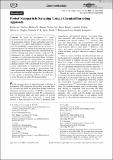| dc.contributor.author | Vaidya, Katherine | |
| dc.contributor.author | Regan, Michael S | |
| dc.contributor.author | Lin, James | |
| dc.contributor.author | Houle, Jenna | |
| dc.contributor.author | Gupta, Aanchal | |
| dc.contributor.author | Stopka, Sylwia A | |
| dc.contributor.author | Agar, Nathalie YR | |
| dc.contributor.author | Hammond, Paula T | |
| dc.contributor.author | Boehnke, Natalie | |
| dc.date.accessioned | 2025-07-10T21:39:25Z | |
| dc.date.available | 2025-07-10T21:39:25Z | |
| dc.date.issued | 2025-01-27 | |
| dc.identifier.uri | https://hdl.handle.net/1721.1/159987 | |
| dc.description.abstract | We report the development of a small molecule‐based barcoding platform for pooled screening of nanoparticle delivery. Using aryl halide‐based tags (halocodes), we achieve high‐sensitivity detection via gas chromatography coupled with mass spectrometry or electron capture. This enables barcoding and tracking of nanoparticles with minimal halocode concentrations and without altering their physicochemical properties. To demonstrate the utility of our platform for pooled screening, we synthesized a halocoded library of polylactide‐co‐glycolide (PLGA) nanoparticles and quantified uptake in ovarian cancer cells in a pooled manner. Our findings correlate with conventional fluorescence‐based assays. Additionally, we demonstrate the potential of halocodes for spatial mapping of nanoparticles using mass spectrometry imaging (MSI). Halocoding presents an accessible and modular nanoparticle screening platform capable of quantifying delivery of pooled nanocarrier libraries in a range of biological settings. | en_US |
| dc.language.iso | en | |
| dc.publisher | Wiley | en_US |
| dc.relation.isversionof | 10.1002/anie.202420052 | en_US |
| dc.rights | Creative Commons Attribution-NonCommercial-NoDerivatives | en_US |
| dc.rights.uri | https://creativecommons.org/licenses/by-nc-nd/4.0/ | en_US |
| dc.source | Wiley | en_US |
| dc.title | Pooled Nanoparticle Screening Using a Chemical Barcoding Approach | en_US |
| dc.type | Article | en_US |
| dc.identifier.citation | Vaidya, Katherine, Regan, Michael S, Lin, James, Houle, Jenna, Gupta, Aanchal et al. 2025. "Pooled Nanoparticle Screening Using a Chemical Barcoding Approach." Angewandte Chemie International Edition, 64 (5). | |
| dc.contributor.department | Massachusetts Institute of Technology. Department of Biological Engineering | en_US |
| dc.contributor.department | Massachusetts Institute of Technology. Department of Chemical Engineering | en_US |
| dc.contributor.department | Koch Institute for Integrative Cancer Research at MIT | en_US |
| dc.relation.journal | Angewandte Chemie International Edition | en_US |
| dc.eprint.version | Final published version | en_US |
| dc.type.uri | http://purl.org/eprint/type/JournalArticle | en_US |
| eprint.status | http://purl.org/eprint/status/PeerReviewed | en_US |
| dc.date.updated | 2025-07-10T21:19:08Z | |
| dspace.orderedauthors | Vaidya, K; Regan, MS; Lin, J; Houle, J; Gupta, A; Stopka, SA; Agar, NYR; Hammond, PT; Boehnke, N | en_US |
| dspace.date.submission | 2025-07-10T21:19:10Z | |
| mit.journal.volume | 64 | en_US |
| mit.journal.issue | 5 | en_US |
| mit.license | PUBLISHER_CC | |
| mit.metadata.status | Authority Work and Publication Information Needed | en_US |
